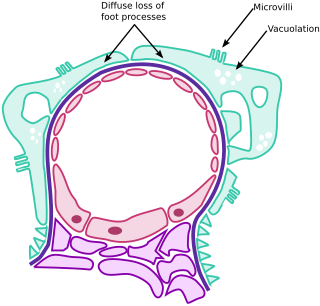Optic neuritis is a demyelinating inflammation of the optic nerve. It is also known as optic papillitis, neuroretinitis when there is a combined involvement of optic disc and surrounding retina in the macular area and retrobulbar neuritis. It is most often associated with multiple sclerosis, and it may lead to complete or partial loss of vision in one or both eyes. Other causes include:
- Idiopathic
- Hereditary optic neuritis
- Parainfectious optic neuritis
- Infectious optic neuritis (sinus related or associated with cat scratch fever, tuberculosis, lyme disease and cryptococcal meningitis in AIDS patients
- Autoimmune causes

Corticosteroids are a class of steroid hormones that are produced in the adrenal cortex of vertebrates, as well as the synthetic analogues of these hormones. Two main classes of corticosteroids, glucocorticoids and mineralocorticoids, are involved in a wide range of physiological processes, including stress response, immune response, and regulation of inflammation, carbohydrate metabolism, protein catabolism, blood electrolyte levels, and behavior.

Cortisone is a pregnane (21-carbon) steroid hormone. It is one of the main hormones released by the adrenal gland in response to stress. In chemical structure, it is a corticosteroid closely related to cortisol. It is used to treat a variety of ailments and can be administered intravenously, orally, intra-articularly, or transcutaneously. Cortisone suppresses the immune system, thus reducing inflammation and attendant pain and swelling at the site of the injury. Risks exist, in particular in the long-term use of cortisone.

Transcortin, also known as corticosteroid-binding globulin (CBG) or serpin A6, is a protein produced in the liver in animals. In humans it is encoded by the SERPINA6 gene. It is an alpha-globulin.

Minimal change disease is a disease affecting the kidneys which causes a nephrotic syndrome. Nephrotic syndrome leads to the loss of significant amounts of protein in the urine, which causes the widespread oedema and impaired kidney function commonly experienced by those affected by the disease. It is most common in children and has a peak incidence at 2 to 6 years of age. MCD is responsible for 10-25% of nephrotic syndrome cases in adults. It is also the most common cause of nephrotic syndrome of unclear cause (idiopathic) in children.

Triamcinolone diacetate is a synthetic glucocorticoid corticosteroid and a corticosteroid ester.

Flunisolide is a corticosteroid often prescribed as treatment for allergic rhinitis. Intranasal corticosteroids are the most effective medication for controlling symptoms.

Alclometasone dipropionate is a synthetic glucocorticoid corticosteroid and a corticosteroid ester.

Tixocortol is a corticosteroid used as an intestinal anti-inflammatory and decongestant.

Prednicarbate is a relatively new topical corticosteroid drug. It is similar in potency to hydrocortisone. Compared to other topical corticosteroids, like betamethasone, repeated prednicarbate use does not cause skin atrophy as quickly. Corticosteroids have always been an important part of the pharmacological arsenal of dermatology; however, their tendency to produce side-effects has caused the need to search for new preparations.

Halcinonide is a high potency corticosteroid, in group II under US classification. It is used topically in the treatment of certain skin conditions.

Clobetasone butyrate is a synthetic glucocorticoid corticosteroid and a corticosteroid ester.

Ulobetasol propionate, also known as halobetasol propionate, is a synthetic glucocorticoid corticosteroid and a corticosteroid ester.

Fluprednisolone is a pregnane. It is a corticosteroid.

Paramethasone acetate is a synthetic glucocorticoid corticosteroid and a corticosteroid ester. It is the acetate ester of paramethasone.

Chloroprednisone acetate is a synthetic glucocorticoid corticosteroid and a corticosteroid ester. It is the 21-acetate ester of chloroprednisone.

Vilanterol is an ultra-long-acting β2 adrenoreceptor agonist (ultra-LABA), which was approved in May 2013 in combination with fluticasone furoate for sale as Breo Ellipta by GlaxoSmithKline for the treatment of chronic obstructive pulmonary disease (COPD).

Flumetasone pivalate is a synthetic glucocorticoid corticosteroid and a corticosteroid ester. It is the 21-acetate ester of flumetasone.

16α-Methyl-11-oxoprednisolone, also known as dexamethasone impurity J, is a synthetic glucocorticoid corticosteroid which was reported in 1979 and was never marketed.


















